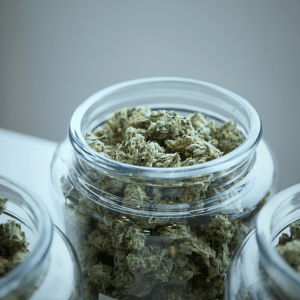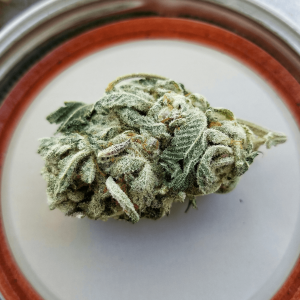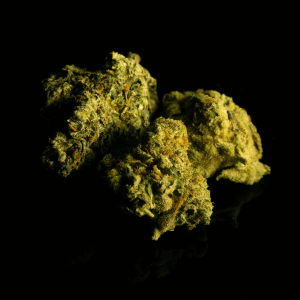It’s finally time we addressed one of the most interesting concepts in the world of weed: The Entourage Effect — a concept that’s been buzzing around cannabis studies and for good reason.
At its core, the Entourage Effect refers to the harmonious teamwork between various compounds found in cannabis. Think of it like a well-oiled jazz band where cannabinoids, terpenes, and flavonoids each play their unique tune, but together create a melody far richer than any solo performance. This effect is significant because it suggests that the therapeutic benefits of cannabis may be amplified when its compounds work collectively, rather than in isolation.
In this blog, we’re diving deep into how this synergy works, why it matters, and what it means for both recreational users and medical patients. We’ll explore the science behind why you may feel different effects from whole-plant cannabis versus isolated compounds, and we’ll lay out some of the most exciting findings from recent studies.
Whether you’re a seasoned cannabis connoisseur, a curious newcomer, or someone interested in the science behind these botanical intracacies, you’ve come to the right place. Expect to gain insightful takeaways about how understanding the Entourage Effect can elevate your cannabis experience. Let’s begin!
What is the Entourage Effect?
The Entourage Effect is a fascinating concept in the cannabis community, where the whole is truly greater than the sum of its parts. This theory suggests that cannabis compounds, including cannabinoids, terpenes, and flavonoids, work collectively to produce a unique synergy. In simpler terms, the combination of these compounds in their natural form can enhance the plant’s therapeutic effects more than any individual component could alone.
The term “Entourage Effect” was popularized by Israeli scientists Raphael Mechoulam and Shimon Ben-Shabat in the late 1990s, although the concept had been floating around in traditional medicine for much longer.
Raphael Mechoulam, a pioneering figure in cannabis research, played a crucial role in highlighting this effect. His studies brought to light how the interplay between different cannabis molecules could modify the body’s response within the endocannabinoid system, enhancing benefits like pain relief and relaxation.
Terpenes, the aromatic oils that give cannabis its distinct flavors and scents, are also key players in this effect. For example, combining the calming terpene linalool with CBD might amplify anxiety-reducing properties, while pinene, another terpene, could enhance focus when paired with THC.
This holistic approach is central to the Entourage Effect, emphasizing how cannabis, in its full-spectrum form, can offer more pronounced benefits and a more well-rounded experience.

History of the Entourage Effect
Although indigenous cultures have long recognized the power of whole-plant medicine, it wasn’t until the late 20th century that scientific research began to catch up. Raphael Mechoulam’s work in the 1960s pioneered the exploration of cannabinoids, leading to the eventual identification of the Entourage Effect.
In the early 2000s, Dr. Ethan Russo, a neurologist and researcher, made significant contributions to the concept with his notable 2011 paper, “Taming THC: Potential Cannabis Synergy and Phytocannabinoid-terpenoid Entourage Effects.” His work provided critical insights into how cannabinoids like THC and CBD, when combined with terpenes, could yield diverse therapeutic effects.
As research progressed, studies began to uncover that cannabis’ therapeutic potential could be maximized when all its compounds worked together, rather than in isolation. This was a shift from the previous focus on single-molecule therapies and highlighted the importance of whole-plant extracts.
The concept gained traction and started influencing product development in the cannabis industry, encouraging a move toward full-spectrum cannabis products that prioritize preserving the plant’s entire chemical profile.
The Science Behind the Entourage Effect
The science behind the Entourage Effect dives into a fascinating interplay between cannabinoids, terpenes, and the body’s receptors. Cannabinoids such as THC and CBD are known to interact with the endocannabinoid system (ECS), a network of cannabinoid receptors throughout the body that helps maintain homeostasis. These interactions occur mainly at the two primary cannabinoid receptor types within the ECS: CB1 and CB2 receptors. For instance, THC’s psychoactive effects result from its ability to bind with CB1 receptors in the brain.
However, the presence of cannabis sativa terpenes, which were initially thought to only contribute flavor and aroma, plays a deeper role. Terpenes can influence cannabinoid activity and potentially modulate receptor affinity, contributing to the overall effect profile of cannabis. For example, the terpene myrcene has been found to increase cell permeability, which can help more cannabinoids cross the blood-brain barrier and enhance the absorption of cannabinoids in the body, potentially amplifying THC’s effects.
Scientific studies have increasingly supported these interactions. Russo’s research demonstrated how specific terpene-cannabinoid combinations could address varied conditions ranging from inflammation to mood disorders. While more research is still needed, the accumulating evidence highlights why users might experience different effects from full-spectrum cannabis extracts compared to products with isolated cannabinoids.
Understanding these scientific nuances helps consumers make informed choices that align with their desired experiences and health objectives, guiding them to embrace the full potential of cannabis through the Entourage Effect.

Key Cannabinoids in the Entourage Effect
In the realm of cannabis science, two cannabinoids often steal the spotlight: THC (tetrahydrocannabinol) and CBD (cannabidiol).
THC is well-known for its psychoactive properties, providing the “high” commonly associated with cannabis use. It’s believed to offer several therapeutic benefits, such as pain relief, appetite stimulation, and reduction of nausea. On the other hand, CBD does not produce a high and is often celebrated for its calming and anti-inflammatory effects, making it a popular choice for alleviating anxiety disorders, seizures, and chronic pain.
Together, these cannabinoids work harmoniously in the Entourage Effect to enhance each other’s properties. For example, while THC can cause anxiety in some users, the presence of CBD might modulate these effects, creating a more balanced experience.
Researchers are discovering that other cannabinoids like CBG (cannabigerol) and CBC (cannabichromene) also contribute to this synergy by enhancing the therapeutic potentials of THC and CBD. This intricate interaction aligns with the principle that the whole of the plant is greater than the sum of its parts.
Role of Terpenes in the Entourage Effect
Terpenes, the aromatic compounds present in many plants, including cannabis plants, play a pivotal role in the Entourage Effect. These molecules are responsible for the diverse scents and flavors associated with different cannabis strains. More importantly, they are thought to enhance or modify the effects of cannabinoids, contributing to the unique profile of each strain.
There are numerous types of terpenes, each with distinct properties:
- Myrcene: Known for its musky aroma, it can promote relaxation and enhance THC’s psychoactivity.
- Limonene: With a citrusy scent, it is believed to elevate mood and provide stress relief.
- Linalool: Often found in lavender, this terpene may offer calming and anti-anxiety benefits.
By interacting with cannabinoids and potentially influencing receptor binding or cell permeability, terpenes contribute to the multifaceted effects of full-spectrum cannabis. For users, this means that the choice of strains with certain terpenes can tailor their cannabis experience to better suit their needs.
Complementary Compounds and Their Effects
Beyond cannabinoids and terpenes, cannabis contains other beneficial compounds, such as flavonoids. These are naturally occurring substances that contribute to the plant’s color and offer additional therapeutic effects. Flavonoids possess antioxidant, anti-inflammatory, and even anti-cancer properties, which can complement the attributes of cannabinoids and terpenes.
The impact of such compounds further underscores the importance of consuming whole-plant cannabis products, where these flavonoids work together with other components to enhance the overall effect profile.
While research into flavonoids and their specific contributions to the Entourage Effect is still emerging, their presence in cannabis indicates a broader spectrum of potential health benefits, reinforcing the idea that nature’s design in the cannabis sativa plant provides an all-encompassing therapeutic solution.
Entourage Effect vs. Single Compound Approach
When it comes to cannabis products, consumers are faced with a choice between whole-plant medicine and isolated compounds.
Whole-plant products embrace the Entourage Effect, utilizing the full spectrum of cannabinoids, terpenes, and other natural compounds found in the plant. Isolate products, on the other hand, focus on specific cannabinoids, such as pure THC or CBD.
Whole-plant medicine offers the benefit of multiple compounds working together synergistically, potentially enhancing therapeutic effects and providing a more balanced experience. This holistic approach can lead to improved symptom relief for conditions like pain, anxiety, and inflammation due to the interaction of various compounds.
However, there are also pros and cons to this approach. One of the advantages of the single compound approach is consistency. With isolates, consumers know exactly what they’re getting, and dose measurements are more precise. This precision is ideal for people seeking specific outcomes without the additional effects from other cannabinoids and terpenes.
Isolates can be particularly useful for those sensitive to THC or who need to pass a drug test. Conversely, the downside is that isolate products may lack the depth of effects that accompany the Entourage Effect, and individuals might miss out on potential therapeutic benefits that come from the synergy of whole-plant medicine.
Deciding between these two approaches ultimately depends on individual preferences and treatment goals. While some may prefer the reliability and straightforwardness of isolates, others might seek the enhanced effects and deeper benefits offered by full-spectrum products. It’s essential to evaluate personal needs and consult with healthcare professionals when choosing between these options to achieve optimal results.
Current Research on the Entourage Effect
Recent studies are continually unraveling the intricacies of the Entourage Effect, enhancing our understanding of how cannabis compounds interact. Researchers are exploring how combinations of cannabinoids and terpenes can impact various health conditions, including chronic pain, epilepsy, and mental health disorders.
A growing body of evidence supports the theory that these compounds, when used together, can amplify therapeutic benefits beyond what isolated compounds can achieve on their own. For example, a recent study published in the journal Nature highlighted how certain terpene-cannabinoid combinations helped reduce inflammation more effectively than isolated CBD or THC. These findings are significant because they suggest that whole-plant extracts may offer superior relief for inflammation-related conditions.
Additionally, ongoing research is looking into the molecular pathways influenced by these combinations, which could potentially lead to new treatment options and cannabis-based therapies in the medical community.
The continuous exploration and advancement in cannabis science are pushing the boundaries of what is known about the Entourage Effect. As researchers uncover more insights, the potential applications of this phenomenon will likely expand, shaping how medical and recreational cannabis users approach treatment and enhancing the efficacy of cannabis-based products for a variety of ailments.
Real-World Applications of the Entourage Effect
The Entourage Effect is not just a theoretical concept; it’s being put into practice in various cannabis-related products in the market today. Many full-spectrum oils, tinctures, and capsules are designed with this effect in mind, offering a blend of cannabinoids and terpenes to deliver comprehensive therapeutic benefits. These products often aim to provide more robust relief from symptoms than isolates, particularly appealing to users seeking wide-ranging health improvements.
Patient testimonials and case studies highlight the practical implications of utilizing the Entourage Effect. For instance, a patient using a full-spectrum CBD oil reported better pain management and mood stabilization compared to using a pure CBD isolate. This aligns with anecdotal evidence suggesting that the combination of multiple compounds may enhance overall effectiveness and offer a more profound relief experience.
Moreover, some medical cannabis clinics are applying the concept of the Entourage Effect to tailor treatments, using combinations that best suit individual patient’s conditions and preferences.
The real-world applications of the Entourage Effect have significant implications for the future of cannabis medicine. As consumers and healthcare providers recognize the advantages of full-spectrum products, there is potential for more personalized and effective treatment plans. Many believe that as research and experience continue to reinforce its efficacy, the Entourage Effect will serve as a cornerstone in the development of innovative cannabis therapies.
Pharmaceutical Interest and Development
The pharmaceutical industry is paying increasing attention to the Entourage Effect, focusing on the unique way cannabinoids and terpenes interact to enhance medicinal cannabis benefits. This growing interest stems from the potential of cannabis compounds to offer effective alternatives to traditional medications, offering relief with fewer side effects.
Pharmaceutical companies are exploring ways to harness these compounds’ interactions, recognizing the promise they hold for developing new treatments for a range of health conditions.
A notable breakthrough is the development of specific cannabis-derived medications designed to maximize the Entourage Effect. One example is Epidiolex, the first FDA-approved prescription medication containing cannabidiol (CBD), which has shown promise in treating certain types of epilepsy. While Epidiolex predominantly contains CBD, ongoing research aims to create formulations incorporating additional cannabinoids and terpenes to potentially enhance treatment efficacy for other conditions.
Another significant development is research into synthetic cannabinoids that mimic the Entourage Effect. Pharmaceutical firms are exploring the idea of creating compounds that can replicate the synergistic interactions found in natural cannabis. This synthetic approach allows for precise formulations, targeting specific health issues without the variability found in plant-based products. By fine-tuning these interactions, researchers hope to produce medications that deliver consistent and reliable outcomes.
Moreover, clinical trials are being conducted to assess the effectiveness of full-spectrum cannabis extract on various medical conditions. These trials are an essential step toward gaining regulatory approval for new medications, providing evidence of the Entourage Effect’s therapeutic potential. As data continues to accumulate, it is shaping a new understanding of how integrated cannabis compounds might provide superior therapeutic options compared to single-compound treatments.
The significant investment and research efforts by pharmaceutical companies illustrate the evolving landscape of cannabis-based medicine. By exploring the Entourage Effect, the industry aims to innovate in the field of natural and synthetic medications. This development not only underscores the potential of cannabis compounds but also paves the way for new and personalized therapeutic solutions that could revolutionize the way we approach treatment for various ailments.

Common Misconceptions
When it comes to the Entourage Effect, there are several myths and misunderstandings that often lead to confusion.
One common misconception is that all full-spectrum cannabis products work the same for everyone. In reality, the effectiveness of these products can vary widely among individuals due to differences in their unique biology and the specific cannabinoid and terpene ratios present in the products.
Another myth is that more cannabinoids always translate to better results. While a diverse profile of cannabinoids and terpenes can enhance potential benefits, it’s important to note that quality and precise formulation play crucial roles.
Here are a few other key clarifications:
Myth: Isolates are inadequate. Many believe isolates can’t provide any therapeutic effects, but they can be effective for some users, especially those seeking a pure form of a specific cannabinoid like CBD.
Myth: Only THC and CBD matter. The Entourage Effect highlights that minor cannabinoids and terpenes can significantly contribute to overall benefits, underscoring their importance beyond just THC and CBD.
Dispelling these misconceptions is vital to fostering a clearer understanding of how the Entourage Effect truly works and its potential applications in cannabis therapy.
Benefits for Various Medical Conditions
The Entourage Effect holds promising potential in addressing a range of medical conditions by enhancing the therapeutic effects of cannabis compounds. This synergistic interaction can contribute to more balanced and potent relief across various health challenges:
- Chronic Pain: Full-spectrum cannabis products can offer comprehensive pain relief by engaging multiple pain-related pathways in the body. The combination of cannabinoids and terpenes may help reduce inflammation and alleviate pain more effectively than isolated compounds.
- Anxiety and Depression: The interplay of cannabidiol (CBD) with terpenes like limonene and linalool can potentially aid in easing anxiety and uplifting mood, providing a holistic approach to managing mental health conditions.
- Epilepsy: As showcased by the medication Epidiolex, which primarily contains CBD, integrating other cannabinoids could enhance its anticonvulsant properties. The Entourage Effect might offer new opportunities for individuals seeking improved control over seizures.
- Sleep Disorders: Terpenes such as myrcene and THC are often associated with sedation. When combined, these could amplify the effectiveness of cannabis in treating insomnia and other sleep disorders, leading to more restful nights.
- Inflammatory Conditions: The anti-inflammatory properties of cannabinoids like CBD, augmented by terpenes with similar effects, could benefit patients with conditions such as arthritis, offering multi-faceted relief from both inflammation and associated pain.
By tailoring cannabis combinations to fit individual patient profiles, healthcare providers can leverage the Entourage Effect to optimize therapeutic outcomes. The key lies in selecting the right mixture of cannabinoids and terpenes for each specific condition, paving the way for personalized and effective treatment strategies.
As research expands, the potential benefits of this synergistic approach continue to offer hope for those seeking alternative solutions to traditional medication.
How to Experience the Entourage Effect
If you’re looking to tap into the Entourage Effect, it’s important to start by finding the right cannabis product that best suits your needs.
First and foremost, research helps a lot. Understanding the different strains and their unique compositions of cannabinoids and terpenes is crucial. Many dispensaries offer full-spectrum products that aim to preserve the natural profile of the plant, maximizing the potential for the Entourage Effect.
When selecting a strain, focus on its cannabinoid and terpene profile rather than just its THC content. Look for strains that have a balanced mix of compounds that align with your health goals, whether it’s stress relief, pain management, or improved sleep. It’s always a good idea to seek advice from knowledgeable budtenders who can guide you based on your personal preferences and health conditions.
Remember to start with lower doses to assess how your body responds, and adjust as necessary. The pathway to experiencing the Entourage Effect is as much about listening to your body as it is about finding the right product.

Market Trends and the Future
The surge in interest around the Entourage Effect has fueled a growing market trend towards full-spectrum and broad-spectrum cannabis products.
Consumers are becoming more educated about the benefits of these multi-compound formulations, pushing demand for products that offer more than just isolated cannabinoids like THC or CBD. This has led to an explosion of cannabis products that highlight diverse cannabinoid and terpene profiles, promising a more holistic therapeutic experience.
Companies are investing in extensive research and development to better understand how to synergise these compounds effectively. As regulations become more favorable and acceptance grows, the next few years are likely to see the emergence of even more sophisticated formulations targeted at specific health conditions.
Innovations such as custom-blended oils and capsules tailored to the individual’s unique health needs could become commonplace. Market analysts predict that as technology continues to advance, the precision in crafting cannabis products to leverage the Entourage Effect will become more refined, offering consumers highly personalized solutions.
With ongoing research and increasing public awareness, the future holds exciting possibilities for the evolution of cannabis medicine within the framework of the Entourage Effect.
Challenges in Entourage Effect Research
Studying the Entourage Effect presents several challenges that researchers are continually trying to overcome. One of the most significant barriers is the legal and regulatory landscape surrounding cannabis research given that it is among the controlled substances federally banned in the United States.
Due to its classification under federal law in many countries, especially the United States, accessing funding and legal clearance to conduct comprehensive studies can be quite cumbersome. This limitation stifles progress as researchers struggle to perform extensive clinical trials that could validate preliminary findings.
Furthermore, the sheer complexity of cannabis as a plant also poses a challenge; it contains an array of cannabinoids and cannabis terpenes, each potentially interacting with one another in numerous ways. Isolating these compounds to understand the specific contributions of each combination is a daunting task.
Additionally, variability in plant chemistry and consumer reactions adds another layer of difficulty in establishing consistent findings. These hurdles collectively mean that despite the growing interest, robust scientific evidence backing the Entourage Effect remains elusive.
Expert Opinions on the Entourage Effect
In the evolving field of cannabis research, the Entourage Effect stands as an area of significant interest and debate among experts. Many leading researchers and industry players emphasize its potential to revolutionize cannabis therapy by optimizing therapeutic outcomes.
Dr. Ethan Russo, a prominent figure in the study of cannabinoids, argues that the synergistic relationships among cannabis compounds can enhance the effectiveness of treatments and reduce reliance on single-molecule medications. He notes that terpenes, often overlooked in mainstream studies, play a pivotal role in modulating the effects of primary cannabinoids like THC and CBD.
Meanwhile, other experts, while acknowledging the promise of the Entourage Effect, advise caution due to insufficient empirical evidence. Dr. Susan Weiss of the National Institute on Drug Abuse highlights the need for more rigorous, controlled studies to substantiate claims made by preliminary research.
Industry specialists like those from GW Pharmaceuticals, a key player in cannabinoid medicine, are invested in exploring this effect further, seeing it as a potential avenue for developing novel, personalized treatment options.
Despite differing views on the immediate applicability and understanding of the Entourage Effect, the consensus is clear: continued research is essential. As knowledge expands, the Entourage Effect is likely to become integral to discussions on the future of holistic cannabis therapies. This dialog reflects diverse perspectives, all contributing to a richer understanding of this complex phenomenon.
Consumer Awareness and Education
As the cannabis industry continues to evolve, increasing consumer awareness and education about the Entourage Effect becomes paramount. Many consumers may initially focus solely on THC or CBD content when selecting cannabis products, not realizing the potential benefits of a full-spectrum approach.
By understanding the symbiotic relationship between various cannabis compounds and how they can work together more effectively, consumers can make more informed choices tailored to their specific needs, whether it be for pain relief, stress management, or overall wellness.
Access to reliable resources is crucial in this educational journey. Fortunately, there are various platforms aimed at bridging the knowledge gap for consumers. Online resources, such as scientific articles and industry blogs like this one, provide insights into the latest research findings.
Educational workshops and seminars hosted by cannabis experts can also offer valuable learning opportunities, creating spaces where consumers can ask questions and gain a deeper understanding. Additionally, dispensaries often employ knowledgeable staff who can offer guidance based on personal health goals and product compositions.
Together, these resources empower consumers to navigate the cannabis market effectively, harnessing the full potential of the Entourage Effect for personalized health solutions.

Conclusion
In summary, the Entourage Effect stands as a pivotal concept in the realm of cannabis therapy, offering a pathway to more comprehensive and effective treatments. By moving beyond isolated cannabinoids and considering the complex interactions between different compounds, the cannabis industry is poised for innovation and growth.
Key challenges remain, especially in terms of robust scientific validation and regulatory hurdles, yet the progress made thus far is promising.
Understanding the Entourage Effect is not just beneficial for industry insiders but also crucial for consumers striving for better health outcomes. Armed with this knowledge, they can make smarter choices and fully leverage the therapeutic benefits cannabis has to offer.
As we look to the future of cannabis medicine, ongoing research and education play vital roles in ensuring that both consumers and professionals can benefit from the complex yet rewarding synergy within the fascinating cannabis plant.
Frequently Asked Questions
1. What is the Entourage Effect?
The Entourage Effect is a concept in cannabis science that suggests the various compounds found in the plant, such as cannabinoids and terpenes, work together to produce a greater effect than any single compound alone. This synergy is believed to enhance the therapeutic benefits of cannabis.
2. How to Get the Entourage Effect?
To experience the Entourage Effect, consider using full-spectrum cannabis products. These products retain a wide range of cannabinoids and terpenes, unlike isolates that focus on a single compound like THC or CBD. Additionally, experimenting with different delivery methods, such as smoking, vaping, or using tinctures, can help you find what works best for your needs.
3. Do Edibles Have the Entourage Effect?
Yes, edibles can offer the Entourage Effect if they are made with full-spectrum cannabis extracts. These edibles contain a variety of compounds that work together to provide the synergistic effects associated with the Entourage Effect. Make sure to check the product labeling to confirm it’s full-spectrum.
4. What Strains Are Good for the Entourage Effect?
Strains that are often recommended for the Entourage Effect are those with diverse cannabinoid profiles and rich terpene content. Some popular strains include Blue Dream, OG Kush, and Pineapple Express. These strains are known for their balanced mix of cannabinoids and terpenes that contribute to a more comprehensive experience. As with any cannabis product, individual experiences may vary, so exploring different strains can help determine which one suits you best.

 Rewards
Rewards




